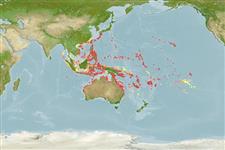Actinopterygii (ray-finned fishes) >
Perciformes (Perch-likes) >
Labridae (Wrasses) > Corinae
Etymology: Halichoeres: Greek, als, alis = salt + Greek, choiros = pig (Ref. 45335).
Environment / Climate / Range
Ecology
Marine; reef-associated; depth range 0 - 5 m (Ref. 30874). Tropical, preferred ?; 32°N - 32°S, 91°E - 133°W
Indo-Pacific: Cocos Island in the eastern Indian Ocean to the Line and Tuamoto islands, north to southern Japan, south to New South Wales and Lord Howe Island. Replaced by Halichoeres nebulosus in the western Indian Ocean.
Size / Weight / Age
Maturity: Lm ? range ? - ? cm
Max length : 12.5 cm SL male/unsexed; (Ref. 9823)
Dorsal
spines
(total): 9;
Dorsal
soft rays
(total): 11;
Anal
spines: 3;
Anal
soft rays: 11. Females olivaceous on back, the scale edges dark brown, pale ventrally, with whitish blotches of unequal size and a large pink area posteriorly on the abdomen; a black spot on opercular flap, small one behind eye, one at front of dorsal fin and a large one rimmed in yellow or blue in middle of fin; no black spot at upper base of pectoral fins; males green with orange-red spots, some linked to form irregular markings, the white blotches and large pink area on abdomen lost, and the black spots lost or reduced. Males are distinguished by different cheek patterns. In this species, it has a near horizontal pink band below the eye (Ref. 48636).
Inhabits shallow reefs and rocky shores, usually in weedy areas exposed to surge (Ref. 9710, 48636). Feeds on benthic crustaceans, mollusks, polychaetes, forams, fishes, and fish eggs (Ref. 1602). One of several similar species that have near identical juvenile and female stages (Ref. 48636).
Life cycle and mating behavior
Maturity | Reproduction | Spawning | Eggs | Fecundity | Larvae
Distinct pairing during breeding (Ref. 205).
Randall, J.E., G.R. Allen and R.C. Steene, 1990. Fishes of the Great Barrier Reef and Coral Sea. University of Hawaii Press, Honolulu, Hawaii. 506 p. (Ref. 2334)
IUCN Red List Status (Ref. 115185)
CITES (Ref. 94142)
Not Evaluated
Threat to humans
Harmless
Human uses
Aquarium: commercial
More information
ReferencesAquacultureAquaculture profileStrainsGeneticsAllele frequenciesHeritabilityDiseasesProcessingMass conversion
Tools
Special reports
Download XML
Internet sources
